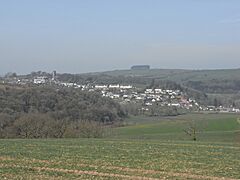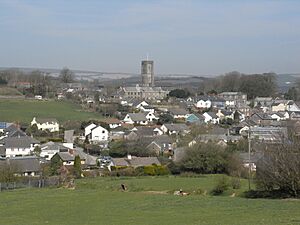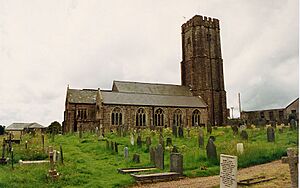North Molton facts for kids
Quick facts for kids North Molton |
|
|---|---|
 North Molton, viewed from the south east. From the church at the top of the hill the village extends down a ridge to the River Mole. Bampfylde Clump is on the horizon |
|
| Population | 721 (2011 Census) |
| Civil parish |
|
| District |
|
| Shire county | |
| Region | |
| Country | England |
| Sovereign state | United Kingdom |
| Post town | South Molton |
| Postcode district | EX36 |
| Police | Devon and Cornwall |
| Fire | Devon and Somerset |
| Ambulance | South Western |
| EU Parliament | South West England |
| UK Parliament |
|
North Molton is a village in North Devon, England. In 2011, about 721 people lived there. The area around the village, called a 'ward', had about 2,206 people.
It's one of the biggest villages in Devon, covering about 15,000 acres. That's like 11,000 football fields! It's near the border with Somerset. Long ago, North Molton was famous for making wool. Later, many people worked in mines nearby.

Contents
A Look Back: North Molton's History
North Molton used to be a 'manor'. A manor was like a large estate or area of land. It was first owned by the King. Then, King John gave it to the la Zouche family.
In 1270, Roger la Zouche got permission to hold a weekly market in the manor. He also got to hold a yearly fair on All Saints' Day. Later, the manor passed to the St Maur family, and then to the Bampfylde family in the 1400s.
Amyas Bampfylde (who died in 1626) built a building called Court Hall. It was next to the church, but it's not there anymore.
Another important family in the village was the Parker family. In 1550, Edmund Parker became the 'bailiff' of the manor. This meant he helped manage the estate. He built Court House in 1553, which is also next to the church.
All Saints' Church
At the top of the village square is All Saints' Church. It has a tall tower, a main area called a nave, and two side aisles. Inside, you can see a beautiful 'rood screen'. This is a decorated screen that separates parts of the church. It's built in a style called Perpendicular Gothic. There are also two smaller screens called 'parclose screens'.
The font, where baptisms happen, is shaped like an octagon. You can also see a fancy wall monument for Sir Amyas Bampfylde (who died in 1626). He was an ancestor of important families like the Bampfylde Baronets and Barons Poltimore.
Bampfylde Clump: A Local Landmark
Bampfylde Clump is a circle of beech trees. It sits on top of Bampfylde Hill, not far from the village. You can see it from many miles away, no matter which direction you are coming from. It's on private land, but there's a path you can use to visit it.
Mining in North Molton
In the 1500s, there were mines near a place called Heasley Mill. Later, more mining happened near North Radworthy. In the early 1800s, people dug for copper there. They even found some gold, but not enough to make it worth mining for money.
By the late 1800s, Bampfylde Mine on the River Mole was producing iron, copper, and manganese. It closed in 1877. Another mine, Florence Mine, was a mile to the east. It mined for iron, copper, and lead until 1885. From 1874, this mine even had a special track, called a tramway, that ran four miles to South Molton railway station.
Historic Estates in the Area
- North Radworthy
- South Radworthy
See also
 In Spanish: North Molton para niños
In Spanish: North Molton para niños



